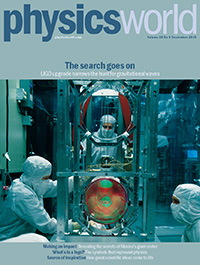By Matin Durrani
How and where do new ideas in physics emerge? We often think they arise serendipitously, which is why we love stories like Newton discovering gravity after seeing an apple fall. The reality, though, is often very different.
Writing in the September 2015 issue of Physics World magazine, which is now out, theoretical physicist Vitor Cardoso from the University of Lisbon explains his efforts to find out how breakthroughs – both big and small – really emerge. As he discovered through his project The Birth of an Idea, it turns out that how new thoughts arise is often much more of a communal activity than we might think.
If you’re a member of the Institute of Physics (IOP), you can get immediate access to this article in the digital edition of the magazine on your desktop via MyIOP.org or on any iOS or Android smartphone or tablet via the Physics World app, available from the App Store and Google Play. If you’re not yet in the IOP, you can join as an IOPimember for just £15, €20 or $25 a year to get full digital access to Physics World.
 For the record, here’s a rundown of the rest of the issue.
For the record, here’s a rundown of the rest of the issue.
• The apple in Culham’s eye – An upgrade to the UK’s Mega Amp Spherical Tokamak could help pave the way for fusion power plants. Michael Banks visits the Culham Centre for Fusion Energy to find out more
• Physics logos – Labs, societies and funding agencies all have logos of one sort or another, but what – if anything – unifies them? Robert P Crease investigates
• Learning from “physics fights” – James Sharp says that the International Physicists’ Tournaments are a great way for students to learn physics
• Catching gravity rolling by – Nearly a century after Einstein predicted the existence of gravitational waves, the long effort to detect them directly is heating up. David Appell explains how a major upgrade at the Laser Interferometry Gravitational-wave Observatory may soon bring the hunt to a successful close
• The secret life of scientific ideas – Dispelling the myth of Eureka moments, Vitor Cardoso describes what he’s learned about how ideas in physics really come about, thanks to the essays penned by physicists in The Birth of an Idea – the web-based project he co-founded with artist Ana Sousa Carvalho
• Revisiting the crater of doom – The Chicxulub impact structure in Mexico is widely believed to be the site of the asteroid impact that allegedly killed the dinosaurs. As Sergio de Régules reports, scientists are now preparing to glean from it new insights into crater formation, materials science and the mechanisms of mass extinction
• Looking back on the H-bomb – Richard Moore reviews Building the H Bomb: a Personal History by Kenneth W Ford
• An insidious and ubiquitous menace –Michael Hunt and Lidija Šiller review Rust: the Longest War by Jonathan Waldman
• Building models, modelling buildings – As a software developer in a building performance analytics firm, Michael Bennett uses his physics skills to help design more environmentally friendly and cost-effective buildings
• Once a physicist – Meet former physics teacher Carol Monaghan, new member of parliament for Glasgow North West, UK
• A natural physicist? – Peter Wright on a strange case of would-be role-reversal
The new ideas are generally the breakthroughs in the highly charged environment of highly tangible things and phenomena that come up in the field of scientific research. At present, in the world of cosmology, the dark energy and the dark matter are squeezing the heads: are they realities or represent the holes in the model used to put together the different ingredients coming from the General Theory of Relativity.
This issue includes a prophetic article on gravitational wave detectors.
Hopefully in the coming months, Physics World will publish a readable and detailed article which explains the modelling and subsequent analysis of the LIGO signal(s) which led to the discovery of the GW150914 gravitational wave source.
This is an amazing piece of science, from both the engineering and physics aspects and is somewhat akin to the Higgs boson discovery.